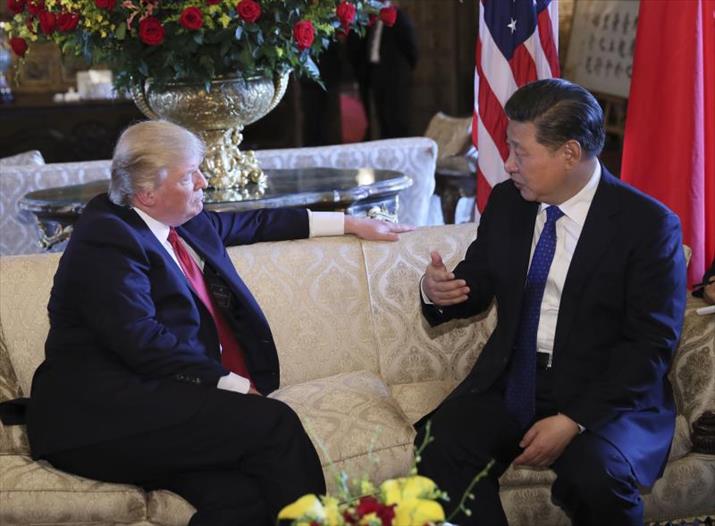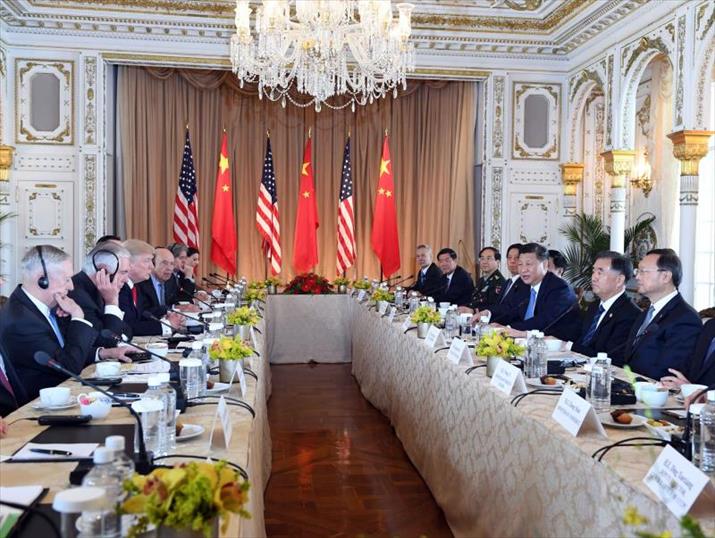| Opinion |
| A Foundation for Trust | |
| Chinese and U.S. presidents' meetings in Florida chart future bilateral ties | |
|
|
 The Chinese President Xi Jinping talks with the U.S. President Donald Trump after his arrival at Trump’s Florida’s resort on April 6 (XINHUA)
With regard to Sino-U.S. relations, described by many as the most important bilateral relationship in the world today, some analysts fear a future trade war between China and the United States as Trump made many inflammatory remarks during his presidential campaign. But many remain optimistic about the bilateral relations because they believe that the ties are so important that neither side would like to see them fail. Chinese President Xi Jinping's meetings with Trump at the Spanish-style Mar-a-Lago resort in Palm Beach, Florida, on April 6 and 7 have helped strengthen bilateral concord. Though no major deals were struck, the face-to-face talks between the two presidents in Trump's "Southern White House" laid the foundation for a sound working relationship and personal trust.  The Chinese President Xi Jinping and U.S. President Donald Trump hold their second formal meeting at the Mar-a-Lago Resort in Florida, U.S., on April 7 (XINHUA)
Comprehensive talks The meetings indicate that both sides are willing to advance dialogue, promote the development of bilateral ties, and seek cooperation in bilateral, regional and world affairs. Over the past 17 years, every American president, from George W. Bush to Obama, worked to build mechanisms for better communication with China. Trump is also doing that. The idea of the Senior Dialogue—a regular, strategic, high-level consultation between China and the U.S.—was conceived in 2004 and the first meeting, called the China-U.S. Strategic Dialogue by China and U.S.-China Senior Dialogue by the U.S., was held in Beijing in 2005. When Obama came into the White House, he continued the dialogue and developed it in a pragmatic way. Very importantly, Obama accepted the definition of "strategic dialogue" that Bush had declined on the grounds that strategic dialogue could be used only between the United States and its allies. The first round of the China-U.S. Strategic and Economic Dialogue (S&ED) was held in Washington, D.C. in July 2009 and the two governments conducted altogether eight rounds of S&ED during Obama's presidency. The China-U.S. high-level dialogues will continue during Trump's term although their forms might change. During Xi's Florida visit, the two governments announced a four-pronged dialogue mechanism. S&ED has now been replaced by a new comprehensive dialogue with four pillars: diplomatic and security dialogue, comprehensive economic dialogue, law enforcement and cybersecurity dialogue, and social and cultural issues dialogue. The framework of the talks and consultations has been confirmed by the two sides, which is part of the important outcomes of Xi's visit. Achieving the four newly announced dialogues in just three months since Trump took office was not an easy feat. With them the meeting paved the way for the two sides to build a new communication pattern in the following years. They are also conducive to the two countries maintaining a stable relationship and strengthening mutual trust as well as carrying out cooperation in the future. China and the United States are the two largest economies in the world with a complex economic relationship of both cooperation and competition. China's rapid growth has brought huge benefits to the United States though the former's development makes the latter feel uneasy. The United States still dominates world affairs but its declining ability can't match its ambition, which makes the country less confident in its dealings with thorny external issues. Trump's winning of the presidential election last year reflects voters' strong demand for change. Trump has expressed determination to reform and change his country but the presidency seems to be a difficult job for the former business tycoon since he lacks political experience. He has encountered problems in selecting members of his cabinet and his executive order on limiting Muslim immigrants to the United States has met with tough opposition in some states even after a revision. On foreign policy, Trump faces discord caused by his administration's dealings with allies like Germany, Japan, Australia and the North Atlantic Treaty Organization. U.S.-Russia relations are also strained. In the face of these troubles, Trump has every reason to smooth relations with China. Better coordination To better evaluate the Mar-a-Lago meetings, the respective targets of China and the United States should be examined. The Trump administration expects to make China compromise on trade and the Korean Peninsula situation. In terms of the U.S. trade surplus with China, Trump is hoping that China can make more effort to "buy American and hire American." Chinese Foreign Minister Wang Yi pointed out after the meetings that China and the United States have agreed to facilitate the healthy development of two-way trade and investment. They will also advance negotiations on a bilateral investment agreement and promote pragmatic cooperation in infrastructure and other areas. During the meetings, the White House saw the possibility of achieving Trump's target on trade and investment by bargaining with China. China and the United States have also agreed to work together on the Korean Peninsula issue. The White House Press Office issued a statement on April 7 to the effect that "the two sides noted the urgency of the threat of North Korea's weapons programs, reaffirmed their commitment to a denuclearized Korean Peninsula, and committed to fully implement UN Security Council resolutions." "They agreed to increase cooperation and work with the international community to convince North Korea to peacefully resolve the issue and dismantle its illegal nuclear and missile programs," the statement said. The two presidents held a telephone conversation and discussed the situation on the Korean Peninsula on April 12, just a few days after their meetings in Florida. The pledge of increasing cooperation on the issue can be seen as an outcome of the meetings. What might be a problem is how to carry out the cooperation on denuclearizing the Korean Peninsula. China is willing to enhance cooperation with the United States but hopes to tackle this challenge in a peaceful way. According to the Chinese foreign minister, "During the meeting, the two leaders exchanged their opinions on the Korean Peninsula nuclear issue and other regional and global affairs of concern. Both sides agreed to expand cooperation at multiple levels to make contributions to world peace, stability and prosperity." China has a firm objection to North Korea's nuclear program and the position is consistent with the U.S. stance. But the two governments have little useful means to stop North Korea from testing its nuclear weapons and ballistic missiles. On April 10, the U.S. Department of Defense disclosed that the U.S. Navy strike group Carl Vinson, led by the aircraft carrier USS Carl Vinson, was sailing north and would be on station in the Western Pacific Ocean after departing from Singapore. Analysts interpret the strike group's stationing as an intended deterrent for North Korea. Trump recently showed his muscle on the Syria issue by launching missile attacks on the Shayrat airfield in Syria on April 6. But the tough stance on North Korea might be met with a tougher response by Pyongyang, which could in turn escalate tensions in Northeast Asia. The newly initiated diplomatic and security dialogue is likely to shoulder the work of implementing the cooperation. Trump has accepted Xi's invitation to pay a state visit to China in the second half of the year. The two sides are also likely to do something on the Korean Peninsula issue in the interim to ensure a successful China visit. Maintaining stable trade and economic ties with the United States was one of Xi's targets for his U.S. visit. For some time, Sino-U.S. economic and trade relations have achieved steady progress. On April 12, Trump went against an earlier campaign promise by saying that he would not label China as a currency manipulator. At the Mar-a-Lago meeting, both sides showed earnest will to adjust economic and trade ties. The White House has spoken highly of Xi's visit and the friendship between the two presidents, which is good news for the development of Sino-U.S. relations. Though the meetings between Xi and Trump have concluded in Florida, the interaction between China and the United States and the implementation of the spirit of cooperation will continue to draw the world's attention. Copyedited by Sudeshna Sarkar Comments to liuyunyun@bjreview.com |
|
||||||||||||||||||||||||||||
|
